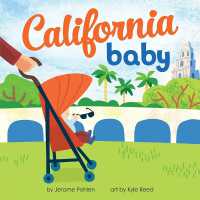- ホーム
- > 洋書
- > 英文書
- > History / World
Full Description
In this major study - regarded as his most important work - the pioneering anthropologist, Berthold Laufer documents the cultural transfers that took place between China and Iran in ancient times. He does so by tracing the history of cultivated plants, drugs, products, minerals, metals, precious stones and textiles, in their migration from Persia to China and from China to Persia. Walnut, peach, apricot and olive, as well as more exotic products like jasmine, henna, indigo, lapis lazuli, amber, coral, gold, ebony, zinc and myrrh are all included. Few other publications provide so much informative detail about the way human activity has modified the natural world through the movement of plants and other natural resource products from one historical civilisation to another. The work also offers important detail on Iran for periods when Iranian sources are slim. Introduced by Brian Spooner, Professor of Anthropology at the University of Pennsylvania, this classic work is once more available for all scholars of Iran, China and cultural exchange.
Contents
CONTENTS
New Introduction by Brian Spooner
Introduction
Sino-Iranica
Alfalfa
The Grape-Vine
The Pistachio
The Walnut
The Pomegranate
Sesame and Flax
The Coriander
The Cucumber
Chive, Onion, and Shallot
Garden Pea and Broad Bean
Saffron and Turmeric
Safflower Jasmine
Henna
The Balsam-Poplar
Manna
Asafoetida
Galbanum
Oak-Galls
Indigo
Rice
Pepper
Sugar
Myrobalan
The 'Gold Peach'
Fu-tse
Brassica
Cummin
The Date-Palm
The Spinach
Sugar Beet and Lettuce
Ricinus
The Almond
The Fig
The Olive
Cassia Pods and Carob
Narcissus
The Balm of Gilead
Note on the Language of Fu-lin
The Water-Melon
Fenugreek
Nux-Vomica
The Carrot
Aromatics
Spikenard—Storax—Myrrh—Putchuck—Styrax benjoin
The Malayan Po-se and Its Products
Alum—Lac—Camphor—Aloes—Amomum— P, o-lo-te—Psoralea—Ebony
Persian Textiles
Brocades—Rugs—Yue no—Woolen Stuffs—Asbestos
Iranian Minerals, Metals, and Precious Stones
Borax—Sal Ammoniac—Litharge—Gold—Oxides of Copper—Colored SaltZinc—-Steel—
Se-se—Emerald—Turquois—Lapis Lazuli—Diamond—Amber—Coral—Bezoar
Titles of the Sasanian Government 529
Irano-Sinica
The Square Bambo—Silk—Peach and Apricot—Cinnamon—Zedoary—Ginger—Mamiran—Rhubarb—
Salsola—Emblic Myrobalan—Althaea—Rose of China—Mango—Sandal—Birch—Tea—Onyx—Tootnague—Saltpetre—Kaolin—Smilax pseudochina—Rag-paper—Paper Money—Chinese Loan-Words in Persian—The Chinese in the Alexander Romance
Appendix I Iranian Elements in Mongol
Appendix II Chinese Elements in Turki
Appendix III The Indian Elements in the Persian Pharmacology
of Abu Mansur Muwaffaq
Appendix IV The Basil
Appendix V Additional Notes on Loan-Words in Tibetan
General Index
Botanical Index
Index of Words








